- Clone
- UCHT1; HCD14; 3G8; HIB19; 2H7; HCD56;
- Regulatory Status
- RUO
- Other Names
- Lin 1
- Isotype
- Mouse IgG1, κ/Mouse IgG2b, κ
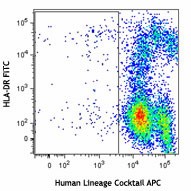
-

Human peripheral blood leukocytes co-stained with CD123 PE and HLA-DR FITC (gated on the Lineage negative/dim population). -

Human peripheral blood leukocytes co-stained with CD123 PE and HLA-DR FITC (gated on the Lineage negative/dim population).
| Cat # | Size | Price | Quantity Check Availability | ||
|---|---|---|---|---|---|
| 348803 | 50 tests | $681.00 | |||
This anti-Human Lineage Cocktail is optimized for the detection of human peripheral blood T cells, B cells, NK cells, monocytes, and neutrophils. In combination with other markers, it can be used for studies of dendritic cells and/or basophils. This cocktail is composed of CD3, CD14, CD16, CD19, CD20, and CD56. CD3 is the antigen mainly found on T cells; CD14 is expressed on monocytes/macrophages and at low levels on neutrophils and eosinophils; CD16 is expressed on NK cells, activated monocytes/macrophages, and neutrophils; CD19 and CD20 are on B cells; CD56 is located on NK cells.
Product Details
- Verified Reactivity
- Human
- Host Species
- Mouse
- Formulation
- Phosphate-buffered solution, pH 7.2, containing 0.09% sodium azide and 0.2% (w/v) BSA (origin USA).
- Preparation
- The antibodies are purified by affinity chromatography and conjugated with APC under optimal conditions.
- Storage & Handling
- The antibody solution should be stored undiluted between 2°C and 8°C, and protected from prolonged exposure to light. Do not freeze.
- Application
-
FC - Quality tested
- Recommended Usage
-
Each lot of this antibody is quality control tested by immunofluorescent staining with flow cytometric analysis. For flow cytometric staining, the suggested use of this reagent is 20 µl per million cells or 20 µl per 100 µl of whole blood. It is recommended that the reagent be titrated for optimal performance for each application.
- Excitation Laser
-
Red Laser (633 nm)
-
Application References
(PubMed link indicates BioLegend citation) -
- Zola H, et al. Eds. 2007. Leukocyte and Stromal Cell Molecules. New Jersey. (FC)
- Product Citations
-
- RRID
-
AB_3097661 (BioLegend Cat. No. 348803)
Antigen Details
- Distribution
-
T cells, B cells, NK cells, monocytes/macrophages, neutrophils
- Cell Type
- B cells, Dendritic cells, Macrophages, Mesenchymal Stem Cells, Monocytes, Neutrophils, NK cells, T cells
- Biology Area
- Immunology, Stem Cells
- Molecular Family
- CD Molecules
- Gene ID
- 915 View all products for this Gene ID 2214 View all products for this Gene ID 930 View all products for this Gene ID 931 View all products for this Gene ID 4684 View all products for this Gene ID 929 View all products for this Gene ID
- UniProt
- View information about Lineage on UniProt.org
Other Formats
View All Lineage Reagents Request Custom Conjugation| Description | Clone | Applications |
|---|---|---|
| FITC anti-human Lineage Cocktail (CD3, CD14, CD16, CD19, CD20, CD56) | UCHT1; HCD14; 3G8; HIB19; 2H7; HCD56 | FC |
| APC anti-human Lineage Cocktail (CD3, CD14, CD16, CD19, CD20, CD56) | UCHT1; HCD14; 3G8; HIB19; 2H7; HCD56 | FC |
| Pacific Blue™ anti-human Lineage Cocktail (CD3, CD14, CD16, CD19, CD20, CD56) | UCHT1; HCD14; 3G8; HIB19; 2H7; HCD56 | FC |
Compare Data Across All Formats
This data display is provided for general comparisons between formats.
Your actual data may vary due to variations in samples, target cells, instruments and their settings, staining conditions, and other factors.
If you need assistance with selecting the best format contact our expert technical support team.
-
FITC anti-human Lineage Cocktail (CD3, CD14, CD16, CD19, CD20, CD56)

Human peripheral blood leukocytes co-stained with CD123 PE a... 
Human peripheral blood leukocytes co-stained with CD123 PE a... -
APC anti-human Lineage Cocktail (CD3, CD14, CD16, CD19, CD20, CD56)
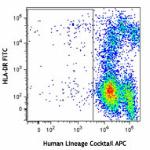
Human peripheral blood leukocytes co-stained with CD123 PE a... 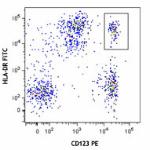
Human peripheral blood leukocytes co-stained with CD123 PE a... -
Pacific Blue™ anti-human Lineage Cocktail (CD3, CD14, CD16, CD19, CD20, CD56)
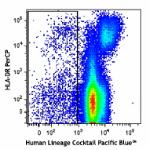
Human peripheral blood leukocytes were stained with Pacific ... 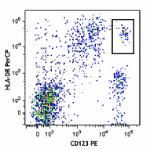
Human peripheral blood leukocytes co-stained with CD123 PE a...
